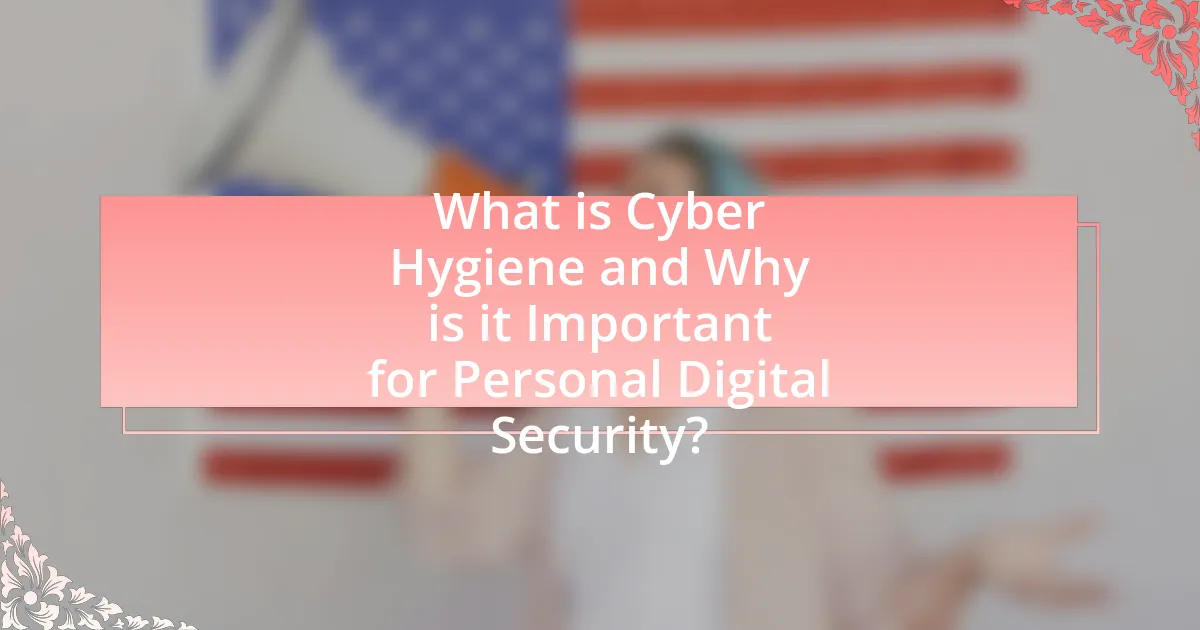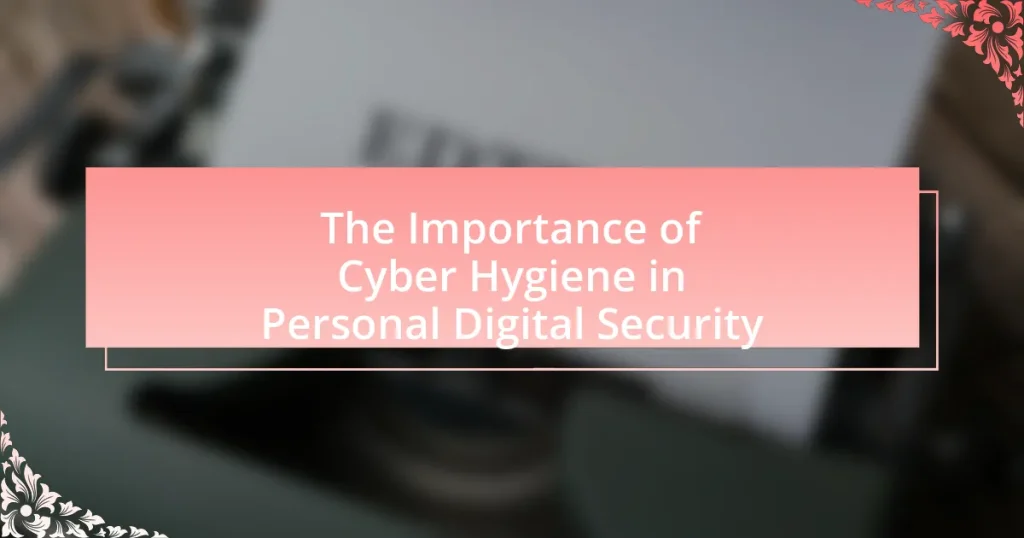Cyber hygiene is the set of practices and steps individuals take to maintain the security and health of their digital devices and online presence. This article emphasizes the importance of cyber hygiene in preventing cyber threats such as malware, phishing attacks, and data breaches. Key principles include regular software updates, strong password management, and safe browsing practices, which collectively enhance personal digital security. The article also discusses common threats mitigated by good cyber hygiene, the financial implications of neglecting these practices, and practical steps individuals can take to improve their cyber hygiene. Additionally, it highlights the role of awareness and education in fostering better security habits.

What is Cyber Hygiene and Why is it Important for Personal Digital Security?
Cyber hygiene refers to the practices and steps individuals take to maintain the health and security of their digital devices and online presence. It is important for personal digital security because it helps prevent cyber threats such as malware, phishing attacks, and data breaches. For instance, according to the Cybersecurity & Infrastructure Security Agency (CISA), regular software updates and strong password management significantly reduce the risk of unauthorized access to personal information. By implementing good cyber hygiene practices, individuals can protect their sensitive data and enhance their overall online safety.
How does Cyber Hygiene contribute to overall digital safety?
Cyber hygiene significantly contributes to overall digital safety by establishing a set of practices that protect devices and data from cyber threats. Regularly updating software, using strong passwords, and implementing multi-factor authentication are key components of cyber hygiene that reduce vulnerabilities. According to a study by the Cybersecurity & Infrastructure Security Agency (CISA), organizations that adopt basic cyber hygiene practices can decrease the likelihood of successful cyber attacks by up to 85%. This demonstrates that maintaining good cyber hygiene is essential for safeguarding personal and organizational digital environments.
What are the key principles of Cyber Hygiene?
The key principles of Cyber Hygiene include regular software updates, strong password management, safe browsing practices, and data backup. Regular software updates ensure that vulnerabilities are patched, reducing the risk of exploitation; for instance, the 2020 Microsoft Exchange Server vulnerabilities highlighted the importance of timely updates. Strong password management involves using complex passwords and changing them regularly, which can prevent unauthorized access, as studies show that 81% of data breaches are linked to weak passwords. Safe browsing practices, such as avoiding suspicious links and using secure connections, help protect against phishing attacks, which have increased by 75% in recent years. Lastly, regular data backups safeguard against data loss from cyber incidents, with 60% of small businesses failing within six months of a cyber attack due to data loss.
How do these principles apply to everyday digital activities?
The principles of cyber hygiene apply to everyday digital activities by promoting safe online behaviors that protect personal information and devices. For instance, regularly updating software and using strong, unique passwords significantly reduce the risk of cyberattacks, as outdated systems are often exploited by hackers. According to a report by the Cybersecurity & Infrastructure Security Agency, 85% of successful cyberattacks exploit known vulnerabilities, highlighting the importance of maintaining updated software. Additionally, practicing caution when clicking on links or downloading attachments can prevent malware infections, as phishing attacks are a common method for compromising personal data. By adhering to these principles, individuals can enhance their digital security and minimize potential threats in their daily online interactions.
What are the common threats that Cyber Hygiene helps mitigate?
Cyber Hygiene helps mitigate common threats such as malware infections, phishing attacks, data breaches, and identity theft. By implementing practices like regular software updates, strong password management, and awareness training, individuals can significantly reduce their vulnerability to these threats. For instance, according to the Cybersecurity & Infrastructure Security Agency (CISA), maintaining updated software can prevent exploitation of known vulnerabilities, which are often targeted by malware. Additionally, the Anti-Phishing Working Group reported that organizations with robust cyber hygiene practices experience fewer successful phishing attempts, highlighting the effectiveness of these measures in protecting personal digital security.
How do phishing attacks exploit poor Cyber Hygiene?
Phishing attacks exploit poor cyber hygiene by targeting individuals who lack awareness of security practices, making them more susceptible to deceptive emails and websites. When users do not regularly update their passwords, fail to enable two-factor authentication, or neglect to verify the authenticity of communications, they create vulnerabilities that attackers can easily exploit. For instance, according to the Anti-Phishing Working Group, in 2021, 83% of organizations experienced phishing attacks, highlighting the effectiveness of these tactics against users with inadequate cyber hygiene. This demonstrates that poor practices, such as using weak passwords or ignoring security alerts, significantly increase the likelihood of falling victim to phishing schemes.
What role does malware play in personal digital security?
Malware significantly undermines personal digital security by compromising devices, stealing sensitive information, and facilitating unauthorized access. It can take various forms, such as viruses, ransomware, and spyware, each designed to exploit vulnerabilities in software or user behavior. For instance, a report from Cybersecurity Ventures predicts that global ransomware damages will reach $20 billion by 2021, highlighting the financial impact of malware on individuals and organizations. Additionally, malware can lead to identity theft, financial loss, and erosion of privacy, making it crucial for individuals to adopt robust cyber hygiene practices to mitigate these risks.

How can individuals implement effective Cyber Hygiene practices?
Individuals can implement effective Cyber Hygiene practices by regularly updating software, using strong and unique passwords, and enabling two-factor authentication. Regular software updates patch vulnerabilities that cybercriminals exploit, as evidenced by a report from the Cybersecurity & Infrastructure Security Agency, which states that 85% of successful cyberattacks leverage known vulnerabilities. Strong passwords, which should be at least 12 characters long and include a mix of letters, numbers, and symbols, significantly reduce the risk of unauthorized access; studies show that 81% of data breaches are linked to weak passwords. Enabling two-factor authentication adds an extra layer of security, making it harder for attackers to gain access even if they have the password.
What are the best practices for maintaining Cyber Hygiene?
The best practices for maintaining Cyber Hygiene include regularly updating software, using strong and unique passwords, enabling two-factor authentication, and being cautious with email attachments and links. Regular software updates patch vulnerabilities, reducing the risk of exploitation; strong passwords prevent unauthorized access, and two-factor authentication adds an extra layer of security. According to a 2021 report by the Cybersecurity & Infrastructure Security Agency, 80% of data breaches involve weak or stolen passwords, highlighting the importance of these practices. Additionally, being vigilant about phishing attempts can significantly decrease the likelihood of falling victim to cyber attacks.
How can regular software updates enhance security?
Regular software updates enhance security by patching vulnerabilities that could be exploited by cyber attackers. These updates often include fixes for known security flaws, which, if left unaddressed, can lead to unauthorized access, data breaches, or malware infections. For instance, a report from the Cybersecurity & Infrastructure Security Agency (CISA) indicates that 85% of successful cyber attacks exploit known vulnerabilities for which patches are available. By consistently applying updates, users can significantly reduce their risk of falling victim to such attacks, thereby improving their overall digital security posture.
What is the significance of strong, unique passwords?
Strong, unique passwords are crucial for protecting personal digital security as they significantly reduce the risk of unauthorized access to accounts. The use of complex passwords that are not reused across multiple sites minimizes the likelihood of successful cyberattacks, such as credential stuffing, where attackers use stolen credentials from one breach to access other accounts. According to a study by the Cybersecurity & Infrastructure Security Agency, 81% of data breaches are linked to weak or stolen passwords, highlighting the importance of implementing strong password practices.
How does awareness and education impact Cyber Hygiene?
Awareness and education significantly enhance Cyber Hygiene by equipping individuals with the knowledge and skills necessary to recognize and mitigate cyber threats. When individuals are educated about potential risks, such as phishing attacks or malware, they are more likely to adopt safe online practices, like using strong passwords and enabling two-factor authentication. Research from the Cybersecurity & Infrastructure Security Agency (CISA) indicates that organizations with comprehensive cybersecurity training programs experience a 70% reduction in successful phishing attacks. This demonstrates that informed users are less susceptible to cyber threats, thereby improving overall digital security.
What resources are available for learning about Cyber Hygiene?
Resources available for learning about Cyber Hygiene include online courses, government websites, and cybersecurity organizations. Online platforms like Coursera and edX offer courses on cybersecurity fundamentals, which cover essential cyber hygiene practices. The Cybersecurity & Infrastructure Security Agency (CISA) provides guidelines and best practices for maintaining cyber hygiene on its website. Additionally, organizations such as the National Cyber Security Centre (NCSC) offer resources and toolkits specifically designed to educate individuals and businesses about safe online behaviors. These resources are validated by their widespread use in educational programs and their endorsement by reputable cybersecurity authorities.
How can individuals stay informed about emerging threats?
Individuals can stay informed about emerging threats by regularly following reputable cybersecurity news sources and subscribing to threat intelligence feeds. Cybersecurity news outlets, such as Krebs on Security and The Hacker News, provide timely updates on vulnerabilities and attacks. Additionally, organizations like the Cybersecurity and Infrastructure Security Agency (CISA) offer alerts and resources that detail current threats and best practices for protection. Research indicates that staying updated through these channels significantly enhances awareness and preparedness against potential cyber threats, as evidenced by a 2021 report from the Ponemon Institute, which found that organizations with proactive threat monitoring were 30% less likely to experience a data breach.

What are the consequences of neglecting Cyber Hygiene?
Neglecting cyber hygiene can lead to severe consequences, including data breaches, identity theft, and financial loss. When individuals or organizations fail to maintain proper cybersecurity practices, they expose themselves to vulnerabilities that cybercriminals can exploit. For instance, according to a report by IBM, the average cost of a data breach in 2023 was $4.45 million, highlighting the financial impact of inadequate cyber hygiene. Additionally, neglecting updates and security protocols can result in malware infections, which can compromise sensitive information and disrupt operations. Overall, the failure to prioritize cyber hygiene significantly increases the risk of cyber threats and their associated repercussions.
What risks do individuals face without proper Cyber Hygiene?
Individuals without proper Cyber Hygiene face significant risks, including data breaches, identity theft, and malware infections. These risks arise from inadequate security practices such as weak passwords, lack of software updates, and neglecting to use antivirus programs. For instance, according to a 2021 report by Cybersecurity Ventures, cybercrime is projected to cost the world $10.5 trillion annually by 2025, highlighting the financial impact of poor cyber hygiene. Furthermore, the Identity Theft Resource Center reported that in 2020, there were over 1,100 data breaches, exposing millions of personal records, which underscores the vulnerability individuals face without implementing basic cyber hygiene measures.
How can identity theft occur due to poor Cyber Hygiene?
Identity theft can occur due to poor cyber hygiene when individuals fail to implement basic security measures, such as using strong, unique passwords and regularly updating software. For instance, weak passwords can be easily guessed or cracked, allowing cybercriminals to gain unauthorized access to personal accounts. Additionally, neglecting software updates can leave systems vulnerable to malware, which can capture sensitive information like Social Security numbers or banking details. According to the Identity Theft Resource Center, in 2021, over 1,800 data breaches exposed more than 300 million records, highlighting the risks associated with inadequate cyber hygiene practices.
What financial implications can arise from cyber incidents?
Cyber incidents can lead to significant financial implications, including direct costs such as data breach response expenses, legal fees, and regulatory fines. For instance, the average cost of a data breach in 2023 was estimated at $4.45 million, according to the IBM Cost of a Data Breach Report. Additionally, organizations may face indirect costs like reputational damage, loss of customer trust, and decreased revenue, which can further exacerbate financial losses. These financial repercussions highlight the critical need for robust cyber hygiene practices to mitigate risks associated with cyber threats.
How can individuals assess their current Cyber Hygiene practices?
Individuals can assess their current Cyber Hygiene practices by conducting a thorough evaluation of their online security habits and tools. This assessment involves reviewing password strength, ensuring software updates are current, and evaluating the use of two-factor authentication. According to a 2021 report by the Cybersecurity & Infrastructure Security Agency, 81% of data breaches are linked to weak or stolen passwords, highlighting the importance of strong password practices. Additionally, individuals should regularly check their privacy settings on social media and other online accounts to ensure they are not oversharing personal information. By systematically analyzing these areas, individuals can identify vulnerabilities and improve their overall Cyber Hygiene.
What tools are available for evaluating personal digital security?
Tools available for evaluating personal digital security include password managers, antivirus software, firewalls, and security assessment tools. Password managers like LastPass and 1Password help users create and store strong passwords securely, reducing the risk of unauthorized access. Antivirus software such as Norton and McAfee scans for malware and protects against threats, while firewalls monitor incoming and outgoing network traffic to block malicious activity. Security assessment tools like Nessus and Qualys can identify vulnerabilities in systems and networks, providing insights into potential security weaknesses. These tools collectively enhance personal digital security by enabling users to manage their credentials, detect threats, and assess vulnerabilities effectively.
How can self-assessment lead to improved Cyber Hygiene?
Self-assessment can lead to improved Cyber Hygiene by enabling individuals to identify vulnerabilities in their digital practices and implement necessary changes. By regularly evaluating their online behaviors, such as password management and software updates, individuals can recognize areas that require enhancement. Research indicates that organizations with self-assessment protocols experience a 30% reduction in security incidents, demonstrating the effectiveness of this approach in fostering better Cyber Hygiene.
What practical steps can individuals take to enhance their Cyber Hygiene?
Individuals can enhance their Cyber Hygiene by implementing strong, unique passwords for each account and enabling two-factor authentication (2FA) wherever possible. Strong passwords reduce the risk of unauthorized access, as studies show that 81% of data breaches are linked to weak passwords. Additionally, regularly updating software and operating systems helps protect against vulnerabilities; for instance, 60% of breaches exploit known vulnerabilities for which patches are available. Individuals should also be cautious with email attachments and links, as phishing attacks account for 90% of data breaches. Regularly backing up data ensures recovery in case of ransomware attacks, which have increased by 150% in recent years. Finally, using reputable antivirus software can detect and mitigate threats, further enhancing overall digital security.
How can creating a digital security checklist improve practices?
Creating a digital security checklist improves practices by providing a structured approach to identifying and mitigating security risks. This systematic method ensures that individuals and organizations consistently follow best practices, reducing the likelihood of security breaches. Research indicates that organizations with documented security policies and checklists experience 50% fewer security incidents compared to those without such measures. By regularly updating and adhering to a digital security checklist, users can effectively manage vulnerabilities, maintain compliance with regulations, and enhance overall cyber hygiene.
What role does regular monitoring of accounts play in Cyber Hygiene?
Regular monitoring of accounts is crucial in Cyber Hygiene as it helps detect unauthorized access and potential security breaches. By consistently reviewing account activity, individuals can identify unusual transactions or login attempts, allowing for timely intervention. For instance, a study by the Identity Theft Resource Center found that early detection of account compromise can reduce the impact of identity theft significantly. This proactive approach not only safeguards personal information but also enhances overall digital security by ensuring that any anomalies are addressed promptly.


